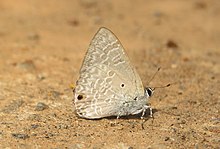Anthene lycaenina
| Pointed ciliate blue | |
|---|---|

| |
| Scientific classification | |
| Domain: | Eukaryota |
| Kingdom: | Animalia |
| Phylum: | Arthropoda |
| Class: | Insecta |
| Order: | Lepidoptera |
| Family: | Lycaenidae |
| Genus: | Anthene |
| Species: | A. lycaenina |
| Binomial name | |
| Anthene lycaenina | |
| Synonyms | |
| |
Anthene lycaenina, the pointed ciliate blue,[2] is a small butterfly found in India that belongs to the lycaenids or blues family found in Indomalayan realm.[2][1] The species was first described by Cajetan Felder in 1868.
Description
It closely resembles Anthene emolus. In both sexes however, but especially in the male, the forewing is distinctly narrower and more acute at apex and the hindwing more acutely angulated at the tornus. In markings on the upperside the two forms are closely alike; on the underside they differ as follows: Ground colour similar but a shade darker. Forewing: the transverse discal band dislocated below vein 3 and shifted inwards so that the short band on the discocellulars and the anterior portion of the discal band form the two branches, the lower portion of the discal band the stem, of a rough Y-shaped figure. Hindwing: a large black or dark brown white-encircled spot touching vein 7 near its base (in A. emolus there is never any trace of such spot). The discal and terminal transverse bands with their pale or white edgings much more broken, irregular and confused. Antennae, head, thorax and abdomen as in the female of A. emolus, but on the underside the palpi, thorax and abdomen whiter with a slight bluish tint.[3][4]
- Upperside (male)
- Upperside (female)
- Underside (male)
- Underside (female)
Subspecies
- A. l. lycaenina (Sri Lanka, southern India)
- A. l. lycambes (Hewitson, 1878) (north-western India to Indo China, Hainan, southern Yunnan)
- A. l. togata (Fruhstorfer, 1916) (Java, Lombok, Sumbawa)
- A. l. villosina (Fruhstorfer, 1923) (Philippines: Luzon)
- A. l. miya (Fruhstorfer, 1916) (Thailand, Malay Peninsula, Singapore, Borneo, Sumatra, Simeulue)
See also
References
- ^ a b Savela, Markku, ed. (November 5, 2018). "Anthene lycaenina (Felder, 1868)". Lepidoptera and Some Other Life Forms. Retrieved October 14, 2020.
- ^ a b R. K., Varshney; Smetacek, Peter (2015). A Synoptic Catalogue of the Butterflies of India. New Delhi: Butterfly Research Centre, Bhimtal & Indinov Publishing. p. 126. doi:10.13140/RG.2.1.3966.2164. ISBN 978-81-929826-4-9.
- ^
 One or more of the preceding sentences incorporates text from this source, which is in the public domain: Bingham, C. T. (1907). The Fauna of British India, Including Ceylon and Burma: Butterflies Volume II. London: Taylor and Francis, Ltd. p. 375.
One or more of the preceding sentences incorporates text from this source, which is in the public domain: Bingham, C. T. (1907). The Fauna of British India, Including Ceylon and Burma: Butterflies Volume II. London: Taylor and Francis, Ltd. p. 375.
- ^
 One or more of the preceding sentences incorporates text from this source, which is in the public domain: Swinhoe, Charles (1910–1911). Lepidoptera Indica: Volume VIII. London: Lovell Reeve and Co. pp. 57–58.
One or more of the preceding sentences incorporates text from this source, which is in the public domain: Swinhoe, Charles (1910–1911). Lepidoptera Indica: Volume VIII. London: Lovell Reeve and Co. pp. 57–58.


External links
 Media related to Anthene lycaenina at Wikimedia Commons
Media related to Anthene lycaenina at Wikimedia Commons Data related to Anthene lycaenina at Wikispecies
Data related to Anthene lycaenina at Wikispecies- Takanami, Yusuke & Seki, Yasuo (2001). "Genus Anthene". A Synonymic List of Lycaenidae from the Philippines. Archived from the original on June 30, 2001 – via Internet Archive. With images.




